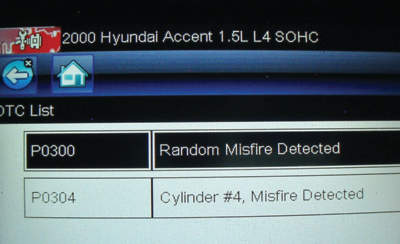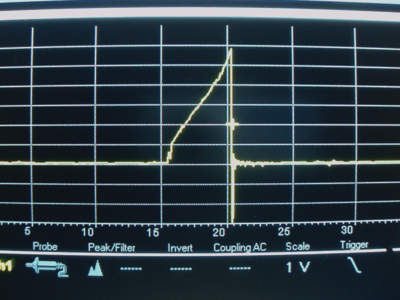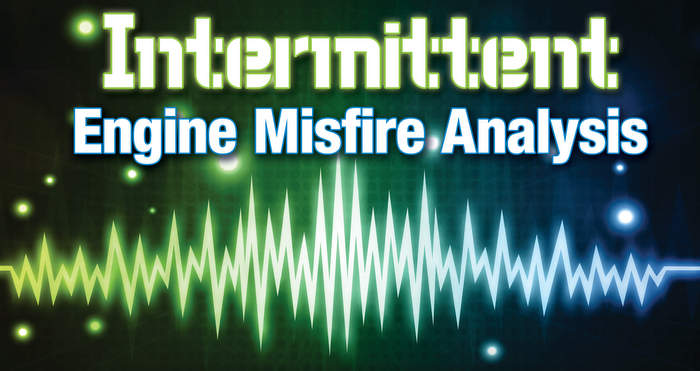Even for an experienced diagnostic technician, attempting to diagnose an intermittent misfire condition that occurs only under specific driving conditions can be a frustrating exercise. Let’s begin by getting the basics out of the way. As we know, the general causes of a misfire fall under the general headings of 1.) ignition, 2.) fuel density, 3.) compression and 4.) timing failures.
The Engine Control Module (ECM) detects a misfire by using the crankshaft position (CKP) sensor to measure the acceleration of the crankshaft when a cylinder fires. When a cylinder fires normally, the crankshaft momentarily accelerates, and when a misfire occurs, the crankshaft momentarily decelerates.

In brief, the PCM counts misfires at 200- and 1,000-rpm intervals and uses this data to sort misfires into Type “A” misfires, that can overheat and damage the catalytic converter, and Type “B” misfires that cause exhaust emissions to exceed the federal test procedure (FTP) standards by 1.5 times.
Type “A” misfires are indicated by a flashing orange “Check Engine” light (CEL), while Type “B” misfires simply illuminate the CEL. Both types of misfires will store a P0300-series diagnostic trouble code (DTC) in the diagnostic memory. As a point of clarification, the fourth zero on a P0300 code indicates a “random” misfire distributed among a majority of cylinders, whereas the fourth digit (ex. P0301) indicates which cylinder is misfiring.
With that said, the misfire detection strategy programmed into specific engine management systems will vary widely among vehicle models, model years and manufacturers. Remember also that a rough idle doesn’t always meet the criteria for storing a cylinder misfire code. See Photo 1.

Ignition Misfires
Intermittent ignition misfires can be caused by faulty spark plugs, spark plug wires, ignition coils and ignition coil drivers located in the ECM. Some intermittent misfires can be more easily detected if a scan tool displays an individual cylinder misfire count in its datastream, or monitors coil activity and variations in burn time and primary coil amperage. Since misfires caused by coolant leaking from cylinder head gaskets often depend upon engine temperature, they can become very intermittent. In most cases, the diagnostic tech must pursue intermittent ignition faults by visually inspecting parts for spark perforation or carbon tracking, or by using a labscope to monitor ignition activity.
Many intermittent ignition misfires can be prevented by using a rubber spark plug holding tool to keep the insulators clean when installing new spark plugs. Using an anti-seize compound is also an issue because the compound must be nickle-based. Manufacturers differ on whether or not to recommend the use of anti-seize, but most do not. Excess anti-seize compound can cause a misfire under load by spattering on spark plug electrodes. Lastly, always install a long-life spark plug that meets the OE manufacturer’s standards for heat range, shell plating and electrode design. See Photo 2.
Fuel Density Misfires
Fuel density misfires are caused by air/fuel (A/F) ratios that are too lean or too rich. A leaking intake manifold gasket or an intermittently clogged or inactive fuel injector, for example, can reduce the fuel density inside the cylinder to the point that it fails to support combustion. Intake manifold gaskets, especially those sealed with rubber O-rings, are often temperature-sensitive and can cause lean misfires when the engine is cold.
A disintegrating substrate in a catalytic converter can also cause intermittent misfires when the cylinders can’t draw enough air to support combustion. When dealing with an intermittent or “hard” cylinder bank misfire, it’s important to determine if the engine is equipped with a catalytic converter on each bank. Keep in mind that many in-line engines are now configured in the ECM with a “bank 1,” which is the front half of the engine and a “bank 2,” which is the rear half.
In many cases, an excessively lean or rich A/F ratio will be accompanied by short- and long-term fuel trims exceeding plus or minus 5% and a P0171/174 (lean) or P0173/175 (rich) diagnostic trouble code. Keep in mind that a rich A/F condition might cause a rough idle, but often won’t store a P0300-series code. Many P0173/175 “rich” trouble codes are mechanically caused by leaking fuel pressure regulators, leaking fuel injectors or excessive fuel pressure.
The more common P0171/174 “lean” codes are typically caused at higher engine speeds by faulty data supplied through the engine coolant temperature (ECT), barometric pressure (Baro), throttle position (TP), mass air flow (MAF) and oxygen sensors (O2). Examples include out-of-the-box problems like broken TP sensor ground wires or by loose debris floating in the MAF sensor housing. Intermittent P0171/174 codes can also be created mechanically by low fuel pump pressures or clogged fuel injectors when the engine is operating under load.














